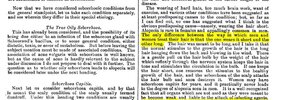" Evidence and implications of inflammation as a characteristic feature of MPHL and FPHL are highlighted through evaluation of clinical and quantitative data. Comparable results suggest the presence of significant perifollicular inflammatory infiltrates, such as lymphocytes and histiocytes, as well as the involvement of inflammatory genes, such as
CASP7 and
TNF, in the presentation of MPHL and FPHL. Resurfacing of the inflammatory aspect in MPHL and FPHL pathogenesis will advance future developments in MPHL and FPHL therapeutic options."
" In a related study, biopsy specimens obtained from over 400 patients with MPHL and FPHL were used to evaluate the presence of perifollicular inflammation with results indicating that approximately 71% of the MPHL and FPHL specimen samples exhibited inflammation"
"Inflammatory infiltrates have been characterized and suggested in the pathogenesis of MPHL and FPHL as observed by an increase in lymphocytes.
17 Immunohistochemical analysis of biopsies obtained from 3 males and 1 female with progressive alopecia revealed follicular infiltration of CD4+ T-cells at the bulge of the hair follicle while control specimen showed a sparse number of T cells.
17 This study concluded that infiltration of inflammatory T-cells at the follicular bulge may be the culprit of the impaired hair cycle and successive hair loss in MPHL and FPHL. Similar evaluation of the role of the inflammatory process in the onset of MPHL was conducted using biopsy specimens from 19 MPHL patients and compared to 6 control subjects.
18 Histopathology of the specimens revealed significant lymphocytic infiltrates in the MPHL patients in comparison to the control subjects. More recently, the role of inflammation in FPHL was studied using scalp biopsies from 52 women with female pattern hair loss.
19 Lymphocytic folliculitis was observed in the obtained biopsies, indicating the presence of inflammation and suggesting lymphocytic infiltrations as a histological feature of MPHL and FPHL"
"The inflammatory role in the pathogenesis of MPHL and FPHL is supported by clinical, histological, and sequencing findings. Perifollicular infiltration of inflammatory cells such as lymphocytes, histocytes, and mast cells is exhibited in biopsy samples of MPHL and FPHL patients. Significant follicular infiltration of CD4+ T-cells has also been observed as a source for impairment of the hair cycle and the consequential hair loss in MPHL and FPHL. RNA sequencing data signifies differential expression of inflammatory genes in MPHL pathogenesis. Conclusively, these findings suggest inflammation is elemental to MPHL and FPHL pathology and reinforce the need to address inflammation in prospective therapeutic developments. "
"We review evidence supporting and challenging dihydrotestosterone’s causal relationship with androgenic alopecia, then propose an evidence-based pathogenesis model that attempts to answer the above questions, account for additionally-suspected androgenic alopecia mediators, identify rate-limiting recovery factors, and elucidate better treatment targets. The hypothesis argues that: (1) chronic scalp tension transmitted from the galea aponeurotica induces an inflammatory response in androgenic alopecia-prone tissues; (2) dihydrotestosterone increases in androgenic alopecia-prone tissues as part of this inflammatory response; and (3) dihydrotestosterone does not directly miniaturize hair follicles. Rather, dihydrotestosterone is a co-mediator of tissue dermal sheath thickening, perifollicular fibrosis, and calcification – three chronic, progressive conditions concomitant with androgenic alopecia progression. These conditions remodel androgenic alopecia-prone tissues – restricting follicle growth space, oxygen, and nutrient supply – leading to the slow, persistent hair follicle miniaturization characterized in androgenic alopecia."
"Biopsies from men with androgenetic alopecia showed a similar pattern of inflammation and immunoreactant deposition. Serologic assessment for antibodies to androgen receptor, estrogen receptor or cytokeratin 15 were negative. Combined modality therapy with minocycline and topical steroids along with red light produced consistent good results in the positive immunoreactant group compared to the negative immunoreactant group.
Conclusion: A lymphocytic microfolliculitis targeting the bulge epithelium along with deposits of epithelial basement membrane zone immunoreactants are frequent findings in androgenetic alopecia"
The studies go on and on and on and on ............
But let's listen to a 25 year old forum kid who knows more than all hair transplant surgeons in the world.
Quite a bold statement. I wonder what powers he has to know exactly what every single doctor has studied and their knowledge about the mechanisms of hair loss.

